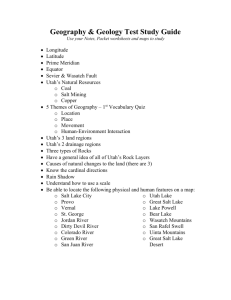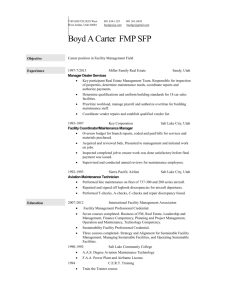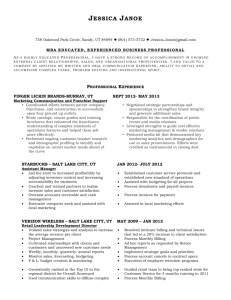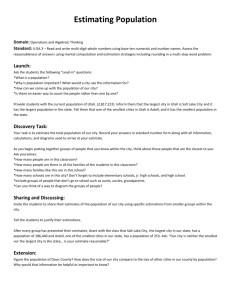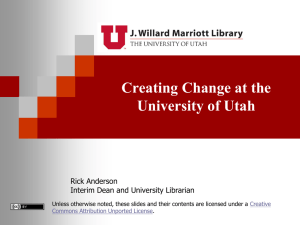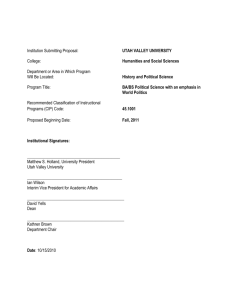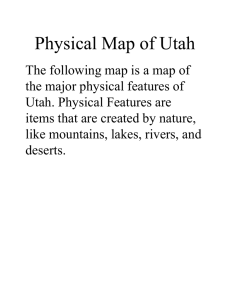J. Willard Marriott Library Profile
advertisement
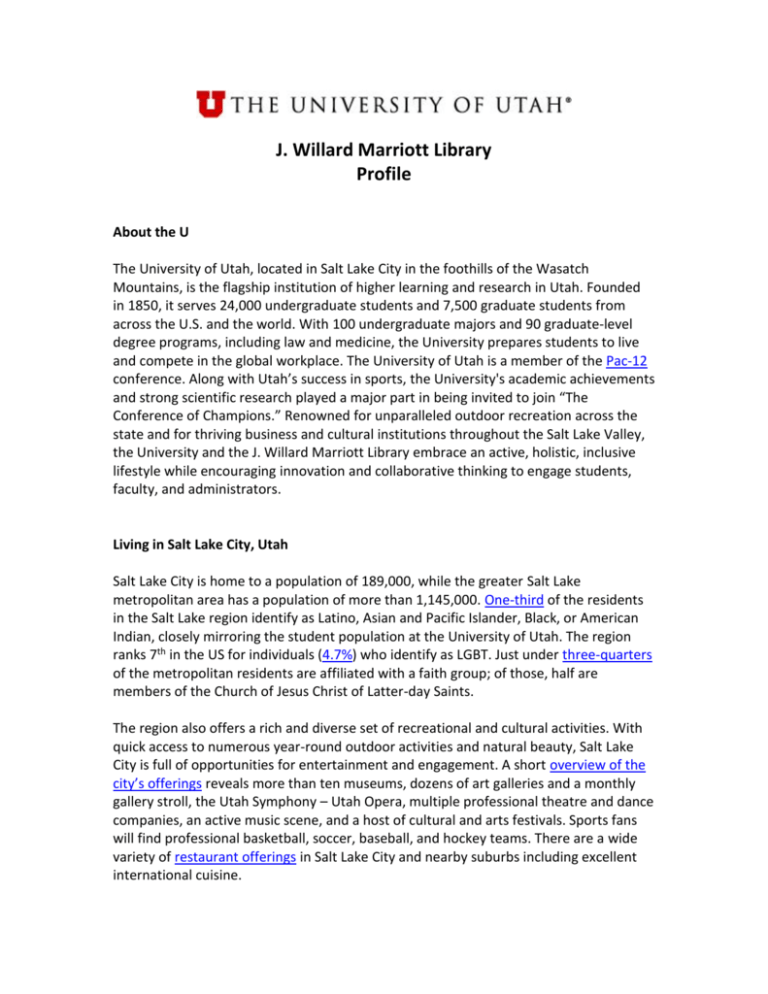
J. Willard Marriott Library Profile About the U The University of Utah, located in Salt Lake City in the foothills of the Wasatch Mountains, is the flagship institution of higher learning and research in Utah. Founded in 1850, it serves 24,000 undergraduate students and 7,500 graduate students from across the U.S. and the world. With 100 undergraduate majors and 90 graduate-level degree programs, including law and medicine, the University prepares students to live and compete in the global workplace. The University of Utah is a member of the Pac-12 conference. Along with Utah’s success in sports, the University's academic achievements and strong scientific research played a major part in being invited to join “The Conference of Champions.” Renowned for unparalleled outdoor recreation across the state and for thriving business and cultural institutions throughout the Salt Lake Valley, the University and the J. Willard Marriott Library embrace an active, holistic, inclusive lifestyle while encouraging innovation and collaborative thinking to engage students, faculty, and administrators. Living in Salt Lake City, Utah Salt Lake City is home to a population of 189,000, while the greater Salt Lake metropolitan area has a population of more than 1,145,000. One-third of the residents in the Salt Lake region identify as Latino, Asian and Pacific Islander, Black, or American Indian, closely mirroring the student population at the University of Utah. The region ranks 7th in the US for individuals (4.7%) who identify as LGBT. Just under three-quarters of the metropolitan residents are affiliated with a faith group; of those, half are members of the Church of Jesus Christ of Latter-day Saints. The region also offers a rich and diverse set of recreational and cultural activities. With quick access to numerous year-round outdoor activities and natural beauty, Salt Lake City is full of opportunities for entertainment and engagement. A short overview of the city’s offerings reveals more than ten museums, dozens of art galleries and a monthly gallery stroll, the Utah Symphony – Utah Opera, multiple professional theatre and dance companies, an active music scene, and a host of cultural and arts festivals. Sports fans will find professional basketball, soccer, baseball, and hockey teams. There are a wide variety of restaurant offerings in Salt Lake City and nearby suburbs including excellent international cuisine. Salt Lake City boasts a number of public transportation options. Built in time for the 2002 Winter Olympics, the TRAX light rail system serves the entire Salt Lake valley and includes a line to the airport. Utah Transit Authority (UTA) bus routes are especially plentiful to the University and run frequently. In winter, routes are added to deliver skiing, snowboarding, snowshoeing enthusiasts to seven resorts. FrontRunner, a commuter rail service, provides an 89-mile link between Salt Lake City and the metropolitan areas of Ogden to the north and Provo to the south. University of Utah employees can use their UCards to ride on all three systems for free, which makes commuting to campus an easy, inexpensive option. Additionally, bikes are allowed on all buses and trains, and bike lanes and trails are being added every year throughout the city, resulting in the League of American Bicyclists naming Salt Lake City as a Silver-level Bicycle Friendly Community. Utah is home to five national parks and many National Monuments and National Forests, many of which are within driving distance of Salt Lake City. Neighboring states offer access to Yellowstone, the Grand Tetons, the Rocky Mountains, and the Grand Canyon. All of these many cultural and recreational activities, combined with the unrivaled beauty of Utah’s outdoors, make Salt Lake City an amazing place to live. Strategic Plans The University of Utah recently held campus-wide dialogue sessions on four major topics to prepare its 2015 self-evaluation report for re-accreditation and to support an emerging campus strategy effort. The four topics are: Promote Student Success to Transform Lives, Develop and Transfer New Knowledge, Improve Health and Quality of Life, and Ensure Long-Term Viability of the University. The Marriott Library has responded to these emerging goals through its own five-year Strategic Directions and accompanying organizational realignment. Key changes include: A new marketing strategy, All U Need, to increase campus awareness of the library’s many resources and services Restructured departments focusing on the user rather than library-driven nomenclature Emphasizing that our employees are a major component of the library’s success and our most important resource. Imagine U In 2013, the University of Utah launched its Imagine U marketing campaign, which highlights the creativity and innovation of University students and employees. There are six Key Supporting Messages. The University of Utah: Is a tier-one teaching and research institution. Offers an extraordinary collaborative learning experience. Combines the energy of a world-class research institution and a cutting-edge health sciences center. Prepares graduates to enter a competitive workforce. Offers a unique and inspiring environment to work and play. Is engaged with the community where we live and work. Innovation, Technology, and Commercialization Research is a major component in the life of the U benefiting students as well as the region. The University of Utah is ranked 47th in the U.S. and 87th in the world in the 2014 Academic Ranking of World Universities. The University of Utah is a national leader for creating start-up companies from University research, according to a ranking by the Association of University Technology Managers (AUTM). Forbes magazine’s recent ranking of the “Best States for Business” pointed to “an educated labor force” as a big reason Utah came in at number one. The U supplies many of the employees for companies that keep expanding their operations in Utah, such as Goldman Sachs, Adobe, Omniture, Oracle, Ebay, and many others. The University and the Marriott Library nurture innovation through a wide variety of centers, support programs and staff, and resources, with a particular focus on students. Commitment to Diversity The University of Utah is deeply committed to enhancing the success of diverse faculty, students, and staff, as part of our broader goal to enrich the educational, work, and life experiences of all members of our University community. The campus offers services to support a diverse faculty, staff, and student body through the Women’s Resource Center, LGBT Resource Center, American Indian Resource Center, Center for Ethnic Student Affairs, International Center, Center for Disability Services, and Veterans’ Support Center. Curriculum offerings encourage students to engage in a broader worldview through courses and programs such as Diversity Scholars, Ethnic Studies, Gender Studies, and an ever growing Language and Literatures Department, which teaches over 20 different languages. Sustainability The University of Utah is a leader in sustainability in higher education illustrated by several initiatives and commitments. For example: Establishing a Chief Sustainability Officer who “oversees the coordination of sustainability-related teaching and training, and academic programs across campus and supports the development of new curricula and student-engagement programs.” President Pershing signed a formal agreement establishing a campus commitment to the Real Food Challenge in February 2015. A University of Utah student-driven initiative, this agreement supports our students who have “joined forces with a nationwide network of student food activists, to shift university food budgets away from industrial farms and junk food and towards the creation and sustainability of local, fair, ecologically sound, and humane food sources.” In June 2105, the University of Utah was recognized by the Environmental Protection Agency (EPA) as a top school for green power purchasing in its College and University Green Power Challenge. Our most recent building projects have obtained LEED Gold and Platinum certifications including the new Law School and the Student Life Center. Healthcare The University of Utah’s Clinical Medicine and Pharmacy was ranked 35th in the world according to the 2015 Academic Ranking of World Universities. This is the second year in a row that we have received this ranking. “The ranking considers several indicators of academic or research performance, including alumni and staff winning Nobel Prizes and Fields Medals, highly cited researchers, papers published in the journals Nature and Science, papers indexed in major citation indices, and the per capita academic performance of an institution, according to the organization.” History of the Marriott Library The current facility for the University of Utah J. Willard Marriott Library was constructed and opened in 1968. At that time, the library housed over one million volumes and provided seating for three thousand students. Wallace Stegner, who was a distinguished alumnus and former professor of the University of Utah and who was awarded the Pulitzer Prize for Fiction in 1972, provided the keynote address for the dedication of the Marriott Library on May 18, 1968. In 1969, the University Library was named in honor of J. Willard Marriott, Sr., who contributed $1 million for library collections. J. Willard and his wife, Alice Sheets Marriott, were both alumni of the University. Mr. Marriott delivered a brief speech to rededicate the building on August 16, 1969. In 1996, the Marriott Library was expanded from 278,000 square feet to 488,000 square feet. The new space contained over thirty-two miles of shelving and a large multimedia center. The building was rededicated on October 2, 1996. Dr. Karen Lawrence, then a professor of English at the University who became president of Sarah Lawrence College in 2007, was the keynote speaker. In 2000, the Marriott Library commenced the multimillion-dollar Renovation-Innovation Capital Campaign to fund major building-wide renovations. Renovation began June 1, 2005 and concluded June 30, 2009. The building remained open to patrons throughout the entire project. The 2009 renovation increased interior space within the library to 516,000 net square feet. New features included the addition of a state-of-the-art Automated Retrieval Center (ARC), a 3-stories high storage facility with a capacity of approximately 2 million items, an audio production studio, a video production studio, more technology-rich classroom spaces, and additional group study rooms. In the years since the rededication additional improvements have been added—most notably the spacious Faculty Center, which opened in January 2013. Located on the ground floor of the library next to the increasingly popular Mom’s Café, the Faculty Center is home to library services and campus partners all of whom support the University’s teaching and research mission. Added in 2014, the Family Reading Room provides users who are also parents a family-friendly study space where they can access university and library resources and meet with peers while their young children play safely nearby. Library Employees The many successes of the Marriott Library are a reflection of a talented and high achieving group of librarians and staff committed to providing the best services possible. There are a total of 42 faculty librarians and 129 full-time staff who comprise the employees of the Marriott Library along with 158 part-time employees. The 2015 reorganization of library personnel created the Digital Library Services unit to focus on our digital creation and preservation efforts, and the Creativity and Innovation Services unit to focus on the development of creative spaces and resources. The Graduate and Undergraduate Services unit provides workshops on successful library research skills, critical thinking skills, and other services to the student population. The Faculty Services unit develops products and services to meet the research and teaching needs of UofU faculty. Subject-focused teams concentrate on increasing outreach to campus departments, institutes, and centers along with collecting, archiving, and providing access to digital and print collections. The Marriott Library is dedicated to the cycle of publishing from idea to finished product, including some online journals. A Copyright Librarian assists faculty with the complicated world of copyright, open access, and Creative Commons. The University of Utah Press is organizationally part of the Marriott Library and has published many award-winning books, especially in the areas of anthropology and archaeology, Mormon Studies and autobiography/memoir. The Library’s Book Arts Program is a highly successful education and outreach program that serves K-12 students, educators, university students, and academic researchers through presentations, classes, and workshops that teach the art of handmade books. The Marriott Library Special Collections has a significant and internationally known collection of digital photos, video, and audio materials along with a nationally recognized collection of manuscripts. An institutional repository, USpace, was created in 2005 and hosts faculty pre-prints, graduate student theses, and poster presentations. Finally, the Espresso Book Machine allows anyone in the campus and local community the potential of self-publishing as well as printing books published before 1923. In 2009, our collection development shifted focus from a traditional, librarian-driven acquisition program to one that is more patron-driven. While our librarians still select materials for the collection and we still buy substantial numbers of printed books, an increased proportion of our collecting is in ebook formats and is driven by patron selections and research behavior. The development of these new collecting models allows the library to integrate electronic resources with traditional library collections and services while incorporating new technologies and formats. Through a combination of patron-directed acquisitions and ongoing scrutiny and modification of our internal processes, we have streamlined access, shortened the time it takes to get people what they need for their research, and ultimately made our collections more tightly aligned with the research and teaching mission of the University. The Marriott Library has a dedication to student success and engagement and thus hosts internships in collaboration with My University Signature Experience (MUSE) along with Library and Information Schools across the country. The Marriott Library continues to reshape its service models and infrastructure to best fit the changing needs of users. Investment in librarians and staff through professional development activities has enabled them to actively engage, remain agile, and contribute expertise to the campus and broader academic community. Other Campus Libraries The J. Willard Marriott Library is joined on the University of Utah campus by three other independent libraries: the Spencer S. Eccles Health Sciences Library, the James E. Faust Law Library, and the McKay Music Library. Several collaborative efforts exist between the Libraries including one integrated online catalog and several teams focused on innovation and data management. Consortial Memberships The University of Utah has long standing relationships with library consortia, which allow for cooperative resource purchasing and sharing. For more than four decades we have been part of the Utah Academic Library Consortium, home to the Mountain West Digital Library, a central search portal for digital collections about the Mountain West region. We are also part of the Greater Western Library Alliance, a consortium of 32 research libraries in the Western and Central United States.
